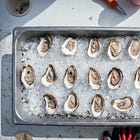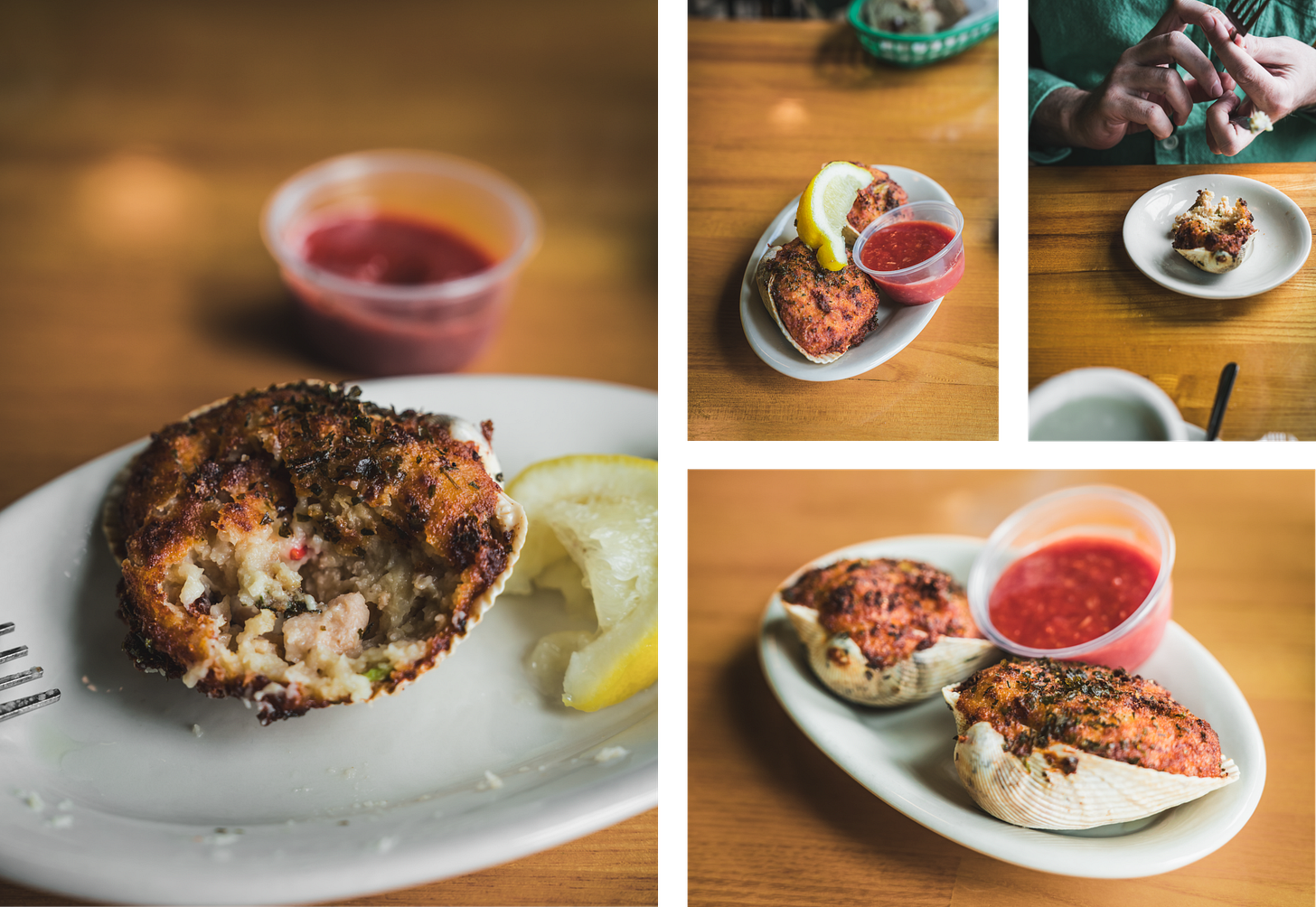The Clam in New England
A humble molusk that was praised by Native Americans, scorned by early settlers, rebranded by nostalgia, and celebrated every summer by New Englanders
The coast of New England is dotted with seafood and clam shacks, serving up all kinds of shellfish by the sea. These Northeastern institutions are tied to summer days and casual lunches, where locals gather with friends and family to eat fried bellies, steamers, or stuffies — all intriguing names I had to learn by ordering them. But clams weren’t always linked to leisure and good times.
Describing a period of famine in 1643 in the Massachusetts Bay colony, Governor John Winthrop described that:
“Many families in most towns… were forced to live off clams, muscles… dry fish” — Winthrop’s Journal, 2:91
First, let’s understand what we are talking about.
Types of clams
In New England there a few varieties of clams for consumption.
Hard Shell or Quahogs - Mercenaria mercenaria
These clams are rounder than soft-shell ones and they are found in the sand and mud habitats of the intertidal and sheltered subtidal. The name — pronounced Koh-hog — is a variation of the Narragansett word “poquauhock”. In the market, they get different denominations according to their size. “Little necks” are the smallest and sweetest, so they are often eaten raw or lightly steamed. “Cherrystones” are a bit larger and they are used for chowder, grilling, stuffing or to be steamed. The largest are simly called “quahogs” or “chowder clams” and their meat is tougher so they are usually minced and added to chowders, clam cakes, or stuffing.
Soft Shell or Long-neck clams - Mya arenaria
These clams are oval in shape and they are referred as “soft shell” because the shell doesn’t completely close due to the protruding rubbery neck, or siphon, of the animal. They live in mud, sand and gravel intertidal areas. They are easy to spot in location at low tide as they make tiny holes in the wet sand with the siphon. They are used for frying and for steaming —therefore they are often referred as steamers.
Surf Clams or Hen Clams - Spisula solidissima
These clams can grow fast to 8 inches or more and weight over a pound. They live burrowed into the sand beneath the turbulent waves of the surf breaker zones. Their meat is often fried into strips and their bellies — also referred as “salvage”— ground up for sauces, chowders or sold as fish bait.
Other clams in the area are the razor clams (Ensis directus) and the mahogany clams (Arctica islandica).
Most of the clams we eat in the region have been farmed. It’s a similar method to the oyster industry (I wrote about it here). They are developed in hatcheries and “planted” in marshes and sandy areas where their growth is controlled. A clear example of this is the Aquacultural Research Corporation (A.R.C.) which plays a very important role in the shellfish comunities of Massachusetts, keeping their waters cleans and the locals’ bellies happy.
“Without clean water and a healthy environment, the shellfish farmer is out of business!” (SEMAC)
But in New England, residents also have the right to harvest their own clams — and many people go clamming on nearby beaches. To do so, you may need to obtain a shellfishing permit from the town where you plan to gather the mollusks, and make sure you’re properly equipped. While it’s technically possible to dig for clams with your hands, it’s much easier with a clam rake to scrape through the muddy — and often rocky — soil, and a bucket to collect your catch. Be sure to check local regulations regarding minimum size limits and, most importantly, go at low tide.
A confused symbol of Yankee nostalgia
As it happened with its relative, the oyster, clams thrived in the area we now call New England a long time before human inhabitants got established there.
Native Americans incorporated shellfish into their diet as a source of protein and their shells were even used as currency. “The New England coastline offered the most stricking evidence of the importance of fish in the Algonquian diet, in the form of the great middens of shells, mostly clams, found there by the early English settlers”1.
Archeological evidence shows that clams and oysters were roasted and baked, sometimes in shallow round pits2. Seventeenth-century writer and explorer William Wood noted “Clamms as big as a pennie white loafe”, so prized that they were “great dainties amongst the natives, and would be in good esteeme amongst the English were it not for better fish”3.
When English settlers established themselves along the New England coast, they adopted the clam for consumption — not an English mollusk, but similar enough to their familiar cockle to risk eating. Still, for the next two centuries, the prevailing sentiment remained that there were, indeed, “better fish” to eat than clams.
Clams were not a first, second, or even third choice. They were associated with the deprivations of early settlement and were typically gathered only in times of scarcity. But why so much disdain for something so abundant?
The first reason was that clams were a pain to get. Gathering enough to feed a family meant hours spent knee-deep in mud, swarmed by flies.
“Remember that it takes four or five hundred oysters or quahogs to feed a family for a day, and that thousands more had to be gathered and dried over smoky fires in the hot summer sun for winter food. Stoop-labor. Sweaty, muddy, back-breaking, and often plaqued by horseflies” — Muir, Reflections in Bullough’s Pond, 10.
The second reason was that shellfish gathering was primarily women’s work. While men fished, women collected mollusks. In a society that viewed women as lower in status, their labor — and by extension, the foods they produced — was seen as less valuable. Clams, therefore, were considered a low-priority foodstuff.
That perception was accentuated with the fact that native Americans enthusiastically ate all kinds of shellfish — the third reason for the low value of clams in English eyes. Curiously, two centuries after the first colonists arrived, the fact that Indians ate clams was no longer a mark of shame but a point of pride. New Englanders began to claim that the beloved tradition of the clambake had been a gift from Native inhabitants — a symbol of friendship. (More on the clambake later.)
In the mid 18th century the perception of the clam began to shift. In 1769, the Old Colony Club — a gentelmen’s club — was founded in Plymouth, the place where the first pilgrims set foot in America. They established new traditions to commemorate the old English colony like the Forefather’s Day banquet every December 22, which included clams, oysters, venison, apple pie and eels.
“In honor to the ancestors of the country, who fed with clams, and other bounties of the sea, they called [the Forefather’s Day meal] a feast of shells”, wrote a Boston journalist in 18064. The clam was leaving its old associations with hardship and becoming a symbol of the natural abundance that fed the revered founders.
Historians Keith Stavely and Kathleen Fitzgerald remind us in their book America’s founding food that the symbolic use of shells was deeply rooted in Catholic Europe —note the pilgrim shell of El Camino de Santiago in Spain. They add:
“The shell has thus become the symbol of the American cornucopia. By the unlikely marriage of a traditional Catholic icon and a traditional Indian food, two negative associations magically canceled each other out and a new Yankee symbol was born”5.
The 19th century solidified the romantizied idea of a glorious past for the newly born nation — and the clam was the perfect symbol to represent abundance and celebration, especially as it took center stage in the politically charged festivity of the clambake.
Some recently published books still claim: “The Algonquin way of cooking seafood packed in seaweed, with ears of corn added — the so-called clambakes— has remained for 350 years a characteristic New England ritual. The Pilgrims learned the ingenious technique from the Indians; seaweed was laid over stones hot enough to cause it to steam, thus cooking corn and shellfish in perfect concordance6.”
However, writer Katherine Neustadt, in her 1992 book Clambake: A History and Celebration of an American Tradition, showed that this tradition did not directly descend from a Native American festival. Instead, it was created by eighteenth-century Yankees as a nostalgic invention to commemorate the arrival of the first Pilgrims.
“However we may ultimately judge its role within Native American cultural practices, the clambake within a Yankee context has been consistently manipulated for a variety of purposes. Particularly during the late nineteenth century, when clambaking reached the zenith of its popularity, the clambake appears as a by-product of a combined romantic and capitalistic fervor.7”
Clams were also gaining prominence in cookbooks, appearing in the form of chowders, soups, stews, and pies.
Stavely and Fitzgerald say:
“The improvement in the clam’s reputation, aided by the invention of the clambake tradition, coincided with the consolidation of various foods and preparations into a self-consciously regional Yankee cuisine”8.
Steamed, stuffed, fried, stewed and baked
The promotion of a regional cuisine — especially in the so-called birthplace of America — was a perfect fit for the growing tourism industry. Food nostalgia was promoted in newspapers and magazines, and people began traveling to the New England coast in search of clam chowders, clambakes, and fried clams.
They still do. Clam and seafood shacks remain a major New England attraction. I had to try it all — I call it research— and learn all the differences as part of my initiation into the Northeastern lifestyle.
Here are all the ways you’ll find clams if you visit the area and indulge in a clam shack.
Fried - Fried bellies / Fried strips
It is said that the fried clam was invented by Lawrence “Chubby” Woodman on July 3, 1916. He had a roadside stand in Essex, Massachusetts, where he sold small grocery items, homemade potato chips, and freshly dug clams. Woodman’s — now an Essex institution— claims on its website that a local fisherman named Tarr once pointed at a bucket of homemade potato chips and jokingly said, “Why don’t you fry up some of your clams? If they’re as tasty as those potato chips of yours, you’ll never have to worry about having enough customers.” The first fried clam was born — and the idea quickly spread.
New Englanders often fight over which is better: “fried bellies” or “fried strips”. The former, as the name suggests, are whole clam bellies battered and fried. The latter are the sliced, less flavorful remains. An offended commenter says, “How is this even a question? Clam strips are not clams, they are deep-fried rubber bands!” While, another argues in deffence of the strips: “No sand in the belly to get in your teeth”.
Whatever your preference, both are usually served with French fries and tartar sauce — or tucked into a sandwich.
Stuffed - Stuffies
This Rhode Island classic features stuffed quahogs — the larger variety of hard-shell clam — and they are delicious! I first tried them at a seafood shack in Plymouth, MA, and didn’t love the flavor. But I knew I had to head down to Rhode Island to taste them at the source.
In Narragansett, there’s a sheafood spot called Aunt Carrie’s that’s been around since 1920. They offer all the classics, and Ross and I indulged in a full dinner — again, research.
Their stuffies are made with minced clam, panko breadcrumbs, and seasoning, all baked into a quahog shell. They came with a spicy tomato sauce, and if it hadn’t been for the rest of the food we had in front of us, I definitely would’ve ordered another round.
Breaded - Clam cakes
As I’m learning with many New England foodstuffs, clam cakes are another item that doesn’t quite match their name. Not a cake, but a fritter — they’re balls of battered clam deep-fried to a bread-like texture. Typically served as an appetizer or finger food, they’re often dunked into clam chowder for extra flavor.
Stewed - Clam chowder
This is perhaps the most well-known New England dish outside the region. I had never heard of it before moving to Boston, but quickly realised that other people from other parts of the U.S. were very familiar with it, and they had even made their own versions.
It’s a soup or stew that varies slightly by region, but the classic New England version is made with chopped clams, diced potatoes, salt pork, onions, and milk. Sometimes it’s thickened with a bit of flour, but most often it’s served with oyster crackers — yet another misleading term, since there’s no oyster in them.
It was the first dish I explored in the region and you can read about it here.
Steamed - Steamers
Steamers are soft-shell clams that are steamed and served with their own cooking liquid and a side of melted butter. They’re an essential part of the traditional clambake and a beloved summertime staple.
“Baked” - Clambake
We’ve already touched on the history of the clambake — a tradition created after the American Revolution, yet long claimed as a Native American feast. Today, it lives on as a beloved summer ritual, and Ross and I had the chance to experience it on our recent trip to Maine.
In Boothbay Harbor, we boarded the Bennie Alice, which took us around the islands of seals and seabirds to Cabbage Island, where the Moore family was kicking off the season of their famous clambakes. It was June 14 and indeed the very first day of the season. The young waitstaff — mostly college students working summer jobs — seemed a little nervous. They mentioned some last-minute cancellations due to a forecast of rain.
A few drops did fall, but it turned out to be a mostly cloudy afternoon — with soft, filtered light to my photographer’s heart delight. The setup was right on the water’s edge, where a few young boys were chopping wood to feed the fire cooking the seafood we would soon relish on.
Their clambake was a traditional one, featuring: lobster (two per person!), steamed clams, an ear of corn, a boiled egg, a baked potato, an onion, and melted butter for dipping. Everything was wrapped in rockweed, which kept the moisture in and lightly flavored the food. The seaweed-covered shellfish and vegetables were placed over boiling pots on the firepit, then covered with canvas tarps to trap the heat and steam the meal slowly.
A bowl of steaming chowder was served first — prepared in the island’s only kitchen — and afterward, we all lined up at the firepit to receive our bounty trays. It was a glorious feast, made even better with the view of the water, and the stories shared by the Moores and their staff. “Many of our customers are locals and they come year after year to enjoy this summer ritual — but we’ve also had people come as far as Kuwait!”.
Not necessarily part of a classic clambake, but a welcome Maine twist, the final course was a slice of blueberry cake. We ate it down to the last bite while chuckling at the contagious laugh from a man sitting beside us that seemed to be having the time of his life.
As we pulled away from the island to return to the harbor, the Moore family waved goodbye, and I noticed a few of the boys still gathered around the firepit. “Not the worst summer job you could have,” I thought — and certainly not the worst way to learn about this mollusk: once prized by Native inhabitants, disdained by early settlers, rebranded by patriotic Americans, and now joyfully celebrated every summer by New Englanders gathered in community.
A humble shell, marked by history and the flavor of summer.
Stavely and Fitzgerald, America’s Founding Food, 78.
Snow, Archeology of New England, 324.
Wood, New Englands Prospect, 37.
Neustadt, Clambake, 32-33 (quoting evidence from Albert Matthews, “The Term Pilgrim Fathers anfd Early Celebrations of Forefathers’ Day” [1915]).
Stavely and Fitzgerald, America’s Founding Food, 90.
Jones, American Food, 23
Neustadt, Clambake, 34.
Stavely and Fitzgerald, America’s Founding Food, 93.
























